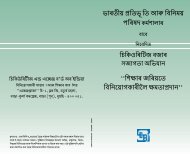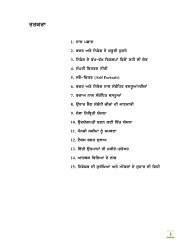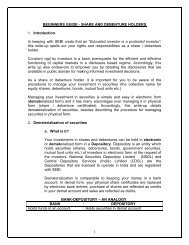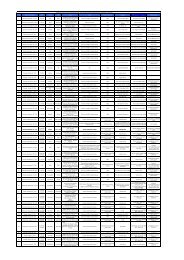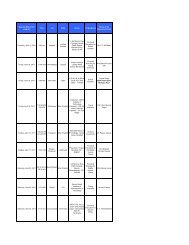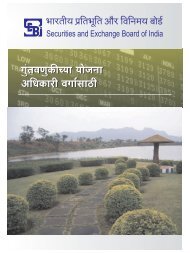financial planning 3. - Securities and Exchange Board of India
financial planning 3. - Securities and Exchange Board of India
financial planning 3. - Securities and Exchange Board of India
- No tags were found...
You also want an ePaper? Increase the reach of your titles
YUMPU automatically turns print PDFs into web optimized ePapers that Google loves.
“The content <strong>of</strong> the book is developed by MultiCommodity <strong>Exchange</strong> (MCX) / FinancialTechnologies Knowledge Management Company(FTKMC) under the guidance <strong>of</strong> the AdvisoryCommittee for the Investor Protection <strong>and</strong>Education Fund (IPEF) <strong>of</strong> <strong>Securities</strong> <strong>Exchange</strong><strong>Board</strong> <strong>of</strong> <strong>India</strong> (SEBI)”Disclaimer:Financial Literacy initiatives <strong>of</strong> the SEBI are forproviding general information to the public. Forspecific information on securities law, rules,regulation, guidelines / directives framed thereunder, please refer to the same atwww.sebi.gov.inPublished by :<strong>Securities</strong> <strong>and</strong> <strong>Exchange</strong> <strong>Board</strong> <strong>of</strong> <strong>India</strong> (SEBI)SEBI BHAVANPlot No.C4-A,'G' Block, B<strong>and</strong>ra Kurla Complex,B<strong>and</strong>ra (East), Mumbai 400051Tel: +91-22-26449000 / 40459000 / 9114Fax: +91-22-26449027 / 40459027E-mail: poonamk@sebi.gov.inEvery effort has been made to avoid errors or omission in this publication. Nevertheless any mistake, errors or discrepancynoted may be brought to the notice at the above mentioned address which shall be rectified in the next edition. It is notifiedthat the publisher will not be responsible for any damage or loss <strong>of</strong> action to any one, <strong>of</strong> any kind, in any manner from use <strong>of</strong>this material.No part <strong>of</strong> this book may be reproduced or copied in any form or by any means (graphic or mechanical, including photocopy,recording, taping or information retrieval systems) or reproduce on any disc, tape, perforated media or other informationstorage device, etc. without the written permission <strong>of</strong> the publisher. Breach <strong>of</strong> this condition is liable for legal action.
1.INTRODUCTIONYou have successfully passed through the many phases <strong>of</strong> life, overcome many hurdlesin your long career, seen the ups <strong>and</strong> downs, <strong>and</strong> so on. Now it’s the time to enter a newphase—Retirement. It means retiring from work, not life. Like changing from the fast lane tothe slower lane where the drive is far more relaxed, scenic <strong>and</strong> pleasurable. It’s just anotherphase in one’s life. Retirement is a state <strong>of</strong> mind as well as a <strong>financial</strong> issue.For most people, the regular income comes in the form <strong>of</strong> a salary, which is paid monthly.Because <strong>of</strong> the regularity <strong>of</strong> income during our working life, we usually adapt our spendingto fit in with our income patterns. By the time retirement comes around we usually have ourincome <strong>and</strong> spending patterns well practised, although these may change a little in retirement.During retirement, or at some stage before, we also need to plan what we are going to do withour retirement savings. Usually this will involve looking at what to do with our superannuationmoney <strong>and</strong> any other savings that we may have accumulated along the way. In view <strong>of</strong> theabove facts, it falls on the concerned person to do <strong>financial</strong> <strong>planning</strong> in a way he/she not onlymaintains the lifestyle but also has <strong>financial</strong> independence as well.2.RETIREMENT PLANThere are many factors related to retirement <strong>planning</strong>, <strong>and</strong> it is never too early to begin. You maydefine your retirement goals <strong>and</strong> need to start a retirement savings plan before consideringactual retirement.Follow the following four simple steps to arrive at an ideal retirement plan.Step 1: Decide how much income you require to live comfortably in your post-retirementyears. Remember to take into account aspects like increased medical costs, expenses <strong>and</strong> giftsfor family.Step 2: Calculate the amount to be received in lump sum (terminal benefits) at the time <strong>of</strong>retirement.Step 3: Select the right retirement plan that enables you to meet your post-retirementrequirements. Preferably, choose to invest in asset classes , which can provide you withpotentially higher returns in the long run.Step 4: Start investing very early so that you have time on your side <strong>and</strong> can enjoy the power<strong>of</strong> compounding.1. Decideyour IncomeRequirement2. CalculateLumpsumReceivable<strong>3.</strong> Select aRetirement Plan4. Start EarlyTake into account• Increased medicalcosts, expenses• Gifts for familyYou ought tocalculate• Terminal benefitsat the time <strong>of</strong>retirementAiming at achieveingpost-retirementrequirements• Invest in assetclasses , providingpotentially higherreturns in the longrunAdvantage <strong>of</strong> havingtime on your side• Reap the benefits<strong>of</strong> compounding4
How much retirement income will I need?An easy rule <strong>of</strong> thumb is that you’ll need to replace 70 to 90 percent <strong>of</strong> your pre-retirementincome. If you’re making Rs20,000 a month (before taxes), you might need Rs15,000 toRs18000 a month in retirement income to enjoy the same st<strong>and</strong>ard <strong>of</strong> living you had beforeretirement.The following example illustrates the amount needed as retirement corpus to ensure a steadyflow <strong>of</strong> monthly income.Calculation <strong>of</strong> retirement corpus:Retirement Age 60Current Age 58Life expectancy 83Years after retirement 23Current Annual ExpensesAverage Return on investment 12%Inflation 5%Inflation adjusted return 7%Total retirement corpus requiredRs 1.80 lakhRs 15 lakhsAction Points: How to Prepare for Retirement?1.2.<strong>3.</strong>4.5.6.It’s never too late to start. It’s only too late if you don’t start at all.Deposit everything you can into your retirement plans <strong>and</strong> personal savings.Reduce expenses <strong>and</strong> funnel the savings into your kitty.Aim for higher returns <strong>and</strong> tax savings. Don’t invest in anything you are not comfortable with.Refine your goals. You may have to live a less expensive lifestyle in retirement.Sell assets that are not producing income or growth <strong>and</strong> invest in income-producing assets.5
Activity(The activity below is designed to help you in setting a <strong>financial</strong> mission <strong>and</strong> a vision.)Activity: read the questions carefully <strong>and</strong> answer them honestly.Your present: What is your current <strong>financial</strong> position? Where do you st<strong>and</strong> today?Your future: What is your <strong>financial</strong> plan for the future? Say 10 years from now!Your reality: Do you have the skills to help you get there? How do you plan to get there?Planning for the future involves setting goals <strong>and</strong> objectives.For each goal, be sure to consider two very important aspects, your risk tolerance <strong>and</strong> the timeframe within which you wish to achieve these objectives. Your personal level <strong>of</strong> risk tolerancewill give you an idea in which securities you need to invest in <strong>and</strong> for how long in order toachieve the set objectives. The duration <strong>of</strong> a <strong>financial</strong> plan depends on the goals that it sets outto achieve. It can cover short-term, medium-term <strong>and</strong> long-term goals. Short-term goals arenormally targeted in a one to three year framework; for example a vacation abroad, mediumtermgoals fit into a three to five year horizon; for example, buying a home; <strong>and</strong> long-termgoals are achieved in a period <strong>of</strong> five years or more; for example, retirement <strong>planning</strong>.It is also important to consider your income per year <strong>and</strong> your level <strong>of</strong> savings. For example,you earn Rs 180,000 a year <strong>and</strong> save 20% <strong>of</strong> it (Rs 36,000). You plan to send your child toMumbai to complete his/her education <strong>and</strong> approximate a budget <strong>of</strong> Rs 200,000. Your child isto complete his HSSE education in four years. Thus, based on your risk tolerance you allocatemoney towards his education. If your risk tolerance is low, it may be difficult to fulfill your goal<strong>of</strong> sending your son to Mumbai to complete his education. But if you are someone who is notafraid to take risks, it is possible to make your dreams come true. Investing money in fundshigher on the risk return scale is one possible solution.Suppose you invest Rs36,000 in the first year, Rs25,000 in the second year, Rs30,000 each in thethird <strong>and</strong> fourth year respectively, your total investment at the end <strong>of</strong> the four year is Rs121,000.Investing in securities that yield an average <strong>of</strong> 22% rate <strong>of</strong> return can enable you to fulfill yourgoal <strong>of</strong> sending your child to Mumbai for his education.8
How did we arrive at this answer?Using the future value formula, we can estimate the required rate <strong>of</strong> return (RROR), you do thison a trial <strong>and</strong> error basis, where ideally Left H<strong>and</strong> Side = Right H<strong>and</strong> Side.FV=∑[PV(1+r)n] = PV(1+r) 4 + PV(1+r) 3 + PV(1+r) 2 + PV(1+r) 1Where, FV= future value PV= present value R= rate <strong>of</strong> return N= number <strong>of</strong>years200,000=36000(1.22) 4 + 25000(1.22) 3 + 30000(1.22) 2 + 30000(1.22) 1200,000=79752.044 +45396.2+ 44652 + 36600200,000= 206,400.244Thus an investment <strong>of</strong> 121,000 in four years for an interest rate <strong>of</strong> approximately 22% willyield 206400.244. Being practical is the most crucial factor in <strong>financial</strong> <strong>planning</strong>; ask yourselfwhether you are able to tolerate such risk that will yield you return <strong>of</strong> 22%.Table 1: Typical long-term goals for Mr PrasannaAge: 50 YearsPr<strong>of</strong>ession: Company ExecutiveGoals Name Target Date Amount (Rs in lakh)Education-doctor Raja (son) 2016 20.00Marriage Ramba (daughter) 2020 35.00House Self 2022 60.00Table 2: Typical short-term goals for Mr PrasannaAge: 50 YearsPr<strong>of</strong>ession: Company ExecutiveGoals Name Target Date Amount (Rs)Visit to Holy Place Self 1-10-2010 20,000Purchase <strong>of</strong> a AC unit Self 1-4-2010 28,000ActivityGoals Your income P.Y. Your savings P.Y. Time frame EstimatedBudget forachievement <strong>of</strong>goalEducationMarriageBuy a houseBuy a carChildren’s educationWorld tourRetirementChildren’s marriageRisk toleranceBased on these aspects please construct a <strong>financial</strong> plan as to which investments you need to invest in, <strong>and</strong> at what amount <strong>and</strong>duration in order to achieve your said targets.9
5.SAVINGS & INVESTMENTFinding the Right Balance between Saving <strong>and</strong> InvestingSaving <strong>and</strong> investing are two related, but independent, processes. Saving is the process <strong>of</strong>putting hard cash aside <strong>and</strong> parking it in extremely safe <strong>and</strong> liquid accounts such as Banksavings accounts. Investing is the process <strong>of</strong> using money (called capital) to buy an asset thatyou think will generate a safe <strong>and</strong> acceptable return over time, making you wealthier witheach passing year. When you save, you’re preserving your money for a later time. When youinvest, you’re taking some risk that you believe will make it possible for your investment togrow in value over time. While investing can help you achieve your long-term goals, saving isan effective way <strong>of</strong> managing your money to meet short-term needs <strong>and</strong> to provide a safetynet for emergency expenses. When saving money, the primary emphasis is on the stability<strong>of</strong> the principal rather than return potential. On the other h<strong>and</strong>, investors are generally morewilling to risk their principal investment for the potential <strong>of</strong> higher returns.6.LOANS vs. INVESTMENTThere is a general confusion among people whether they should avail a loan or buildinvestments to achieve their <strong>financial</strong> goal (for example, daughter’s marriage). There is no rulewhich says that either <strong>of</strong> the option is good, because it differs for each person’s capacity <strong>and</strong>the nature <strong>of</strong> debt or investment. The following points are worth remembering:• It purely depends on your <strong>financial</strong> strength <strong>and</strong> other factors.• Credit card debts <strong>and</strong> personal loans are very costly.• If you have a loan with a low interest rate <strong>and</strong> tax benefits as in the case <strong>of</strong> home loans, it isadvantageous to go for a loan. If you have an investment plan where you can make goodreturn, then you may opt for investment.• You have to be sure that the investment is not risky <strong>and</strong> will not affect your family if youlose the money. For example, you are investing huge sums in share market, instead <strong>of</strong>closing the existing debts, that is very risky.7.PERSONAL BUDGET CALCULATORHave a budget. Determine what you actually spend each month. There are fixed expenseslike rent, loan repayments, etc. every month about which we can do little. The variable itemssuch as food, clothing <strong>and</strong> entertainment are <strong>of</strong>ten what get money away from us. Use yourdiscretion to contain these variable expenses to start saving.10
A Personal Budget is simple to prepare.Income. Add up your monthly income: salary <strong>and</strong> investment income.Expenses. Add up monthly expenses: rent, loan payments, average food bills, medicalexpenses, entertainment, <strong>and</strong> so on. Determine an average for expenses that vary each month,such as clothing, or that don’t occur every month, such as car insurance. You will need to trackhow you spend cash for a month or two. Most <strong>of</strong> us are surprised to find out where <strong>and</strong> howmuch cash “disappears” each month.Subtract expenses from income. What if you have more expenses than you have income?Not an uncommon problem. You have three choices: cut expenses, increase income, or both.Cut expenses. There are ways to reduce expenses, from reducing grocery consumption toshopping for low-cost items without compromising quality. Compare monthly variancesbetween actual expenditure <strong>and</strong> budgeted expenditureIncrease income. Improve your job skills or education to get a better paying job, or makemoney from a hobby. It is hard to apply a rule <strong>of</strong> thumb toward savings, because it varies withage <strong>and</strong> income level. Ten percent is a good start. If you find that is too high for you, don’t letthat deter you. You can start by putting a little aside each month <strong>and</strong> then slowly increasingit.ActivityPrepare a monthly budget by specifying your income in terms <strong>of</strong> all inflows <strong>of</strong> cash fromwhatever sources, after which you need to deduct all possible expenses you think will ariseduring the month. It is important to do this exercise before the start <strong>of</strong> the month so that youcan anticipate what can be the likely level <strong>of</strong> investments. Rule <strong>of</strong> thumb ideally says that youneed to save 20% <strong>of</strong> your income. Complete this exercise to see whether you really are!A: IncomeSalaryRentInterest per monthCapital gainsBusinessOther sourcesTOTAL INCOMEB: ExpensesTravel <strong>and</strong> transportFood <strong>and</strong> utilitiesRentLeisureInsurance premiumChildren’s educationHolidaysOtherTOTAL EXPENSESC: Savings = income − expenditureYour monthly budget11
To find out whether you are saving 20% <strong>of</strong> your income, you just need to multiply your savingsby 100 <strong>and</strong> divide it by your total income. If the value is below 20, it means you are spendingyour money recklessly giving you an indication to start saving … it’s never too late!Typical Monthly BudgetJan 2010Name: Krishnan, Age 59 Company ExecutiveIncome Amount (Rs) Expenses Amount (Rs)Salary 75,500 Committed (EMI) 32,500Investment Income 6,000 Living Expenses 28,700PensionOther expensesOthers PF/LIC 10,500Income 81,500 Total Expenses 71,700Net Surplus 9,8008.PERSONAL NETWORTH CALCULATORYour networth is simply the total value <strong>of</strong> what you own (assets) minus what you owe (liabilities).It’s a snapshot <strong>of</strong> your <strong>financial</strong> health. The first step in <strong>planning</strong> your finances is to know whereyou <strong>financial</strong>ly st<strong>and</strong> today, i.e., ascertaining your networth. Your networth is the differencebetween what you own <strong>and</strong> what you owe.Your Assets Your Liabilities Your NetworthInclude personal possessions,vehicles, home, savingsaccount, <strong>and</strong> cash value <strong>of</strong> lifeinsurance policies.Value <strong>of</strong> investments−shares,real estate, deposits, PFaccounts.The remaining loanoutst<strong>and</strong>ing on your home,credit card debt, car loans,personal loans, incometaxes dues, <strong>and</strong> any otheroutst<strong>and</strong>ing bills.Calculate your networth periodically, say quarterly <strong>and</strong> keep track <strong>of</strong> changes. An increasingnetworth means you are doing well <strong>financial</strong>ly.Keep in mind the following points while calculating your networth1. Use current market value/realizable value.2. Estimate if you can’t be accurate.<strong>3.</strong> Be conservative.4. Avoid insignificant detail.12
Model Networth StatementName: RajaAge: 58Pr<strong>of</strong>essional in a companyNetworth as on 31-01-2010Assets Rs (in lakhs) Liabilities Rs (Lakhs)House 56.00 Home loan 17.50Savings a/s 00.32 Car loan 05.20Equities 0<strong>3.</strong>50 Credit card 02.40Fixed Deposit 05.00 Personal loan 06.10Car 06.20 Total 31.20NSC 04.30Total 75.32 Networth 44.129.RISK vs. RETURNEvery individual has his/her own risk taking capacity. Your risk-return pr<strong>of</strong>ile is your level <strong>of</strong> risktolerance. A high risk venture is normally associated with high returns. You could be one <strong>of</strong> thefollowing three risk-return pr<strong>of</strong>iles or somewhere in between them:1.2.<strong>3.</strong>Conservative, i.e., you take minimal risks ensuring your funds are secure. You preferinvesting in post <strong>of</strong>fice deposit schemes, bank fixed deposits, <strong>and</strong> government bonds.Moderate, i.e., you are willing to take some risks <strong>and</strong> prefer investing in mutual fundschemes.Aggressive, i.e., you are willing to take high risks <strong>and</strong> prefer investing in equity, commoditiesmarkets, <strong>and</strong> you may even be speculating for returns.Higher the risk, the higher the return! This is an important investment principle. Managing thelevel <strong>of</strong> risk is what investing is all about. There is no investment without some risk, includingputting money in the bank. Always check the potential risks when quoted returns are unusuallyhigh.It is also important to know your risk pr<strong>of</strong>ile. The following activity will help you estimate thesame:Given below is a questionnaire designed to help you underst<strong>and</strong> the type <strong>of</strong> investor you really13
are. Please do answer honestly by choosing the appropriate option.1.2.<strong>3.</strong>4.5.What is your major investment objective?a) High returnb) Moderate returnc) Liquidityd) Low riske) SafetyIn which asset class would you like to allocate your funds?a) Stocksb) Mutual fundsc) Real estated) Fixed depositse) BondsWhat is your expectation on annual return from your investments?a) >100%b) 50-75%c) 25- 50%d) 10-25%e) 5yearsAccording to you, under which category do you belong?a) Adventurousb) Opportunisticc) Plannerd) Conservativee) No risk takerScoring: Each <strong>of</strong> the above option carries a score. Option (a) carries 1 point, (b) 2 points, (c) 3 points, ( d) 4points, <strong>and</strong> (e) 5 points.ScoresResults5-10 Highest risk takers: Thrill seekers, creative <strong>and</strong> extroverted, you work hard <strong>and</strong> play hard. Safety bores you - eventhough your actions may have <strong>financial</strong>ly adverse consequences.10-15 High risk takers: you are confident, strong-willed <strong>and</strong> are ready to take chances.15-20 Moderate risk takers: you primarily look for security <strong>and</strong> safety in your investments, undertake minimumresistance, you put your money in places where previous experience has worked for you!20-25 Low risk takers: you are not at all risk oriented. You believe in self sufficiency. You seek peace <strong>of</strong> mind, you don'tlike to become too involved with <strong>financial</strong> management causing stress.14
Here’s an example <strong>of</strong> some <strong>of</strong> the asset allocation models for different stages in your investing life.What they show is a gradual movement from aggressive to conservative style <strong>of</strong> investment.Asset MixYears to retirement Stocks Bonds Cash20 80% 10% 10%15 60% 30% 10%10 40% 50% 10%5 30% 60% 10%Remember that models such as these aren’t designed to predict a particular level <strong>of</strong> return.While allocating assets can help you moderate risk, it doesn’t eliminate the possibility <strong>of</strong>accumulating less than you’d like. Also, remember that an asset allocation isn’t fixed—as timepasses <strong>and</strong> you near retirement, you may want to consider shifting some <strong>of</strong> your stock holdingsinto more conservative choices to avoid the impact <strong>of</strong> short-term drops in the market.10. COMPOUNDINGTime exerts the greatest influence on your investment portfolio than any other force.Through the power <strong>of</strong> compounding, a small amount <strong>of</strong> money over time can grow into asubstantial sum. Compounding is an investor’s best friend. Investments can increase in valueover time, <strong>and</strong> the longer the time frame, the greater the value. This is achieved through returnsthat are earned, but not spent. When the return is reinvested, you earn a return on the return<strong>and</strong> a return on that return <strong>and</strong> so on. Therefore, it is important to start saving early in order tobenefit from the power <strong>of</strong> compounding returns.The time value <strong>of</strong> money is the value <strong>of</strong> money that has earned an interest over a given amount<strong>of</strong> time. For example: Rs 100 invested today for one year at 5% interest will be Rs105. Thus, tothe investor, Rs 100 paid now is no different than Rs 105 paid one year from now.The valuation <strong>of</strong> a likely stream <strong>of</strong> income in the future, in such a way that the annual incomesare discounted <strong>and</strong> then added together, thus providing a lump-sum “present value” <strong>of</strong> theentire income stream that is likely in the future. Thus PV is the present value <strong>of</strong> future money.For example, a sum <strong>of</strong> FV to be received in one year is discounted at a rate <strong>of</strong> interest to give asum <strong>of</strong> PV at present:PV = FV/ (1+r)Future cash flows are discounted at the discount rate, the higher the discount rate, the lowerthe present value <strong>of</strong> the future cash flows. The importance <strong>of</strong> time value <strong>of</strong> money in investment<strong>and</strong> conserving the value <strong>of</strong> your money is crucial. You need to invest in order to protect thevalue <strong>of</strong> your moneyActivity: List down the various items you <strong>of</strong>ten use <strong>and</strong> write down their value today <strong>and</strong>their value 10 years back. Compare the two values <strong>and</strong> observe how the value <strong>of</strong> money haschanged over time.15
Table: The time value <strong>of</strong> moneyAssets Price 10 years ago (-10) Price now (0) Price 10 years from now(+10)1 Property/ house2 Gold (10 gms)3 Investments :• Sensex/ Nifty• Bonds• Fixed deposits interest rate4 Rice5 College Education67Power <strong>of</strong> CompoundingLet’s compare two friends Raman <strong>and</strong> Prasad. Raman starts saving Rs 2,000 per year fromthe age <strong>of</strong>19. After eight years, he stops investing money. On the other h<strong>and</strong>, Prasad startsinvesting Rs 2,000 per year when he is 27 <strong>and</strong> continues investing this amount every year tillhe is 65.Raman invested Rs16,000 <strong>and</strong> Prasad Rs 74,000.If both earn 10% post-tax return per annum on their investments, who will have more wealthwhen they retire at age 65?Raman. His Rs 2,000 annual savings between age 19 <strong>and</strong> 27 will aggregate to Rs 1,019,161by age 65, whereas, Prasad’s Rs 2,000 annual savings between age 27 <strong>and</strong> 65 will aggregateRs 805,185 lakhs. There is a 64-fold increase in Raman’s investment whereas it is a 10-foldincrease for Prasad.To summarize, the power <strong>of</strong> compounding is the single most important reason for you tostart investing right now. Remember, every day that your money is invested, is a day thatyour money is working for you.Here’s how much your money would grow if you make a lump-sum (one-time) investment <strong>and</strong>leave it untouched. The interest rate has been assumed to be 10%.Amount lump-sum payment (Rs)Years 100,000 200,000 300,000 400,000 500,0005 161,051 322,102 483,153 644,204 805,25510 259,374 518,748 778,123 1,037,497 1,296,87115 417,725 835,450 1,253,174 1,670,899 2,088,62420 672,750 1,345,500 2,018,250 2,691,000 3,363,75025 1,083,471 2,166,941 3,250,412 4,333,882 5,417,35330 1,744,940 3,489,880 5,234,821 6,979,761 8,724,701Reading the table: if you plan on investing money for a period <strong>of</strong> say 30 years <strong>and</strong> have acorpus <strong>of</strong> Rs 1 lakh compounded, you would get a return <strong>of</strong> Rs 17,44,940.ActivityIf Ram, aged 60 years, would like to gift Rs 20 lakh to his son after 20 years, how much he hasto invest now? Use the table given above16
11. Inflation effects on investmentsIf your investment portfolio includes a big portion <strong>of</strong> fixed income securities, you should payattention to inflation rates.Most susceptible to rising inflation rates are retirees that have fixed income. This is so sinceinflation decreases the purchasing power <strong>of</strong> money <strong>and</strong> retirees will be able to purchase lesswith their money than before.Inflation eats away your purchasing power. For instance, if the average rate <strong>of</strong> inflation is 8%,you need to make sure that your investments are earning a minimum <strong>of</strong> 8% or more, post-tax.Let us assume an investment portfolio <strong>of</strong> Rs 1,00,000, earning returns at 10% <strong>and</strong> inflation at8%. The returns in this case would be Rs 10,000 gross annually, with the net after income taxRs 7000 (Assuming you are in the highest tax bracket <strong>of</strong> 30%). Now, if you account for the 8%inflation specified (8000, or 8% <strong>of</strong> Rs 100,000), you are left with Rs (- ve) 1000 (Return <strong>of</strong> 7000minus inflation <strong>of</strong> 8000). It means you are not earning any money in real terms.12. Investment Comm<strong>and</strong>mentsHere are some Guidelines for you to follow.•••••••••••Do establish clear <strong>and</strong> reasonable investment goals before you invest.Do remember that there are risks in any investment. As potential pr<strong>of</strong>it increases, so doesrisk.Do diversify your investment portfolio to decrease your overall risk.Do select the appropriate asset mix <strong>of</strong> debt, equity, <strong>and</strong> cash equivalents.Do recognize the limits <strong>of</strong> your knowledge. Avoid investments you don’t underst<strong>and</strong>.Do your homework. Be sure you know what you are investing in <strong>and</strong> what impact it willhave on the risk, potential returns, <strong>and</strong> marketability <strong>of</strong> your portfolio.Do keep in mind that income-tax is payable on your investment while making investmentdecisions.Don’t invest on the basis <strong>of</strong> hot tips <strong>and</strong> rumours. They are seldom right.Don’t blindly follow investment advice that you don’t underst<strong>and</strong>.Don’t be afraid to say NO to the suggestions <strong>of</strong> your <strong>financial</strong> adviser if you are notconvinced the investments are right for you.Don’t take risks you can’t afford or aren’t comfortable with. Underst<strong>and</strong> your tolerance forrisk.Investment StrategiesDiversification aims to reduce the risks by investing money in a range <strong>of</strong> companies orproducts <strong>and</strong> by ensuring it is available at a different time; that is, not putting all your eggsin one basket. You may want to spread your money with several different institutions, withvarious investment types <strong>and</strong> across different markets, such as cash, fixed income securities,shares <strong>of</strong> companies or mutual funds.If you are investing in fixed interest investments, it may be wise to spread your money so thatyou have different maturity dates. This reduces some <strong>of</strong> the risk if interest rates change. It canalso provide you with income on a more regular basis. While you should always spread your17
RiskUnsystemic riskNumber <strong>of</strong> stocksSystemic riskrisk over several investments, having many small investments may involve a lot <strong>of</strong> supervision,The diagram above depicts how simple diversification in stocks can considerably reduce theunsystemic risk to a more manageable level. Diversification beyond a point will not have animpact <strong>and</strong> there by will not reduce the risk further. Any risks faced after diversification is bornedue to market risk or systemic risk.Asset allocationAsset allocation is the process <strong>of</strong> deciding what proportion <strong>of</strong> an investment a portfolioshould have in terms <strong>of</strong> different types <strong>of</strong> investment (shares, bonds, real estate, etc.) <strong>and</strong>markets (debt,equity or commodity). Asset allocation can improve both diversification <strong>and</strong>performance — although these aims do conflict, to an extent. It helps ensure that investmentsare spread out across a wide range <strong>of</strong> markets <strong>and</strong> securities, <strong>and</strong> the allocations should bechosen to avoid investing too much in markets <strong>and</strong> securities whose movements are stronglycorrelated with each other. Asset allocation can boost performance by identifying marketsor sectors that are undervalued as a whole. Correctly identifying these will clearly improveperformance.1<strong>3.</strong>INVESTMENT VEHICLESAfter retirement, people save for two main reasons. The first is to protect their desired st<strong>and</strong>ard<strong>of</strong> living against unforeseen reductions in their income or increases in their expenses. Everyretired person wants to maintain the same lifestyle as he/she had during pre-retirementdays. So he must ensure that his post-retirement income is adequate <strong>and</strong> in the vicinity <strong>of</strong>his pre-retirement income. When one grows old, the fear <strong>of</strong> medical problems rises. Expenseson medical cover are also to be met. A regular medical cover taken during pre-retirementdays should be continued to protect oneself from medical problems. The need <strong>of</strong> the houris ensuring a regular income as substitute for salary to meet day-to-day expenses. This canbe achieved through careful deployment <strong>of</strong> retirement benefits like provident fund benefits,gratuity, etc. in instruments that yield interest income at regular intervals.Pension PlanRegular income could be obtained with the help <strong>of</strong> pension products chosen during earlierstages <strong>of</strong> life. Such plans ensure regular pension during retirement period. In case a person hasnot taken these plans, earlier, he can go for an immediate pension plan like the ones <strong>of</strong>feredby insurers. In a typical pension plan you have the flexibility to make a lump-sum payment ora regular contribution every year during your earning years. Your money is then invested infunds <strong>of</strong> your choice. You can opt to receive the annuity at any time after vesting age (age atwhich you become eligible for pension chosen by you at the inception <strong>of</strong> the plan). Most <strong>of</strong>the Unit linked pension plans also come with a wide range <strong>of</strong> annuity options, which gives you18
choice in structuring the post-retirement benefit pay-outs. Also, at the time <strong>of</strong> vesting you canmake a lump-sum tax-exempted withdrawal <strong>of</strong> up to 33 percent <strong>of</strong> the accumulated corpus.CASE STUDYRaman 59, is <strong>planning</strong> to retire in six months’ time when he reaches 60. Currently, hisretirement nest is worth around Rs 7,50,000. He intends to use it to buy an annuity, <strong>and</strong> wantsone that will provide income for him. As a non-smoker, with no serious health problems, hewould receive an income <strong>of</strong> Rs 45,000 per year or Rs 3,750 a month (assuming an annuityrate <strong>of</strong> 6%) for the rest <strong>of</strong> his life.Monthly Income PlanOne can also get into the Monthly Income Scheme <strong>of</strong> post <strong>of</strong>fice or banks. This plan ensuresregular interest income. This ensures safety <strong>and</strong> liquidity <strong>of</strong> funds. Present rate <strong>of</strong> returns inmonthly income plan <strong>of</strong> post <strong>of</strong>fice is 8% p.a.ActivityGeorge, a factory worker is about to retire at the age <strong>of</strong> 60. His terminal benefits (PF, Gratuityetc )is worth Rs 300,000, <strong>and</strong> he also has savings <strong>and</strong> investments that are worth aroundRs 90,000. George has decided that he will take 25% <strong>of</strong> his terminal benefits as a tax-freelump sum for his daughter’s marriage. This will leave him with Rs 225,000, which he plans toinvest <strong>and</strong> withdraw income from.Suggest a monthly income plan that would ensure safety, liquidity <strong>and</strong> decent return?Mutual Funds• A mutual fund is generally a pr<strong>of</strong>essionally managed pool <strong>of</strong> money from a group <strong>of</strong>Investors.• A mutual fund manager invests your funds in securities, including stocks <strong>and</strong> bonds, moneymarket instruments or some combination <strong>of</strong> these, based upon the fund’s investmentobjectives.• By investing in a mutual fund you can diversify, thereby sharply reducing your risk. Mutualfunds can be classified on the basis <strong>of</strong> structure.Open-Ended Scheme sells <strong>and</strong> repurchases units at all times. When fund sells, investor buys<strong>and</strong> when the investor redeems, the fund repurchases the units. Buying or redeeming is at aprice based on the NAV. (Net Asset Value)Under Close-Ended Scheme, after the <strong>of</strong>fer closes, investors are not allowed to buy or redeemunits from the fund. Close-ended funds are listed on stock exchanges to enable investors tobuy or sell units.Systematic Investment planThis is a simple, disciplined strategy <strong>of</strong> investing your money in a mutual fund. This is a longtermstrategy for accumulation <strong>of</strong> wealth. SIP investor gets good rate <strong>of</strong> returns compared toa one time investor. In an SIP a specific amount should be invested in regular intervals in amutual fund for a specific period, which is very similar to a recurring deposit. It allows you tobuy units <strong>of</strong> the fund each month, ignoring the volatility in the market. While your investmentremains the same, more number <strong>of</strong> units can be bought in a declining market <strong>and</strong> less number19
<strong>of</strong> units in a rising market. Thus you automatically participate in the market swings once theoption for SIP is made. SIP work on the principle <strong>of</strong> rupee cost averaging. It ensures averaging<strong>of</strong> rupee cost as consistent investment ensures that average cost per unit fits in the lowerrange <strong>of</strong> average market price. SIP generally starts at minimum amounts <strong>of</strong> Rs 1,000 per month<strong>and</strong> upper limit for using an electronic clearing service (ECS) is Rs 25,000 per instruction.Working <strong>of</strong> SIPAn added advantage <strong>of</strong> a SIP is that it allows you to invest in the market without trying tosecond guess its movements. Since you commit to investing a fixed amount every month,say Rs 500, when the market is high, the corresponding NAV <strong>of</strong> the fund is also high, thusyou get fewer units on your investment <strong>of</strong> Rs 500, than you would when the markets <strong>and</strong> thecorresponding NAV are low.MONTH NAV NUMBER OF UNITS (500/NAV)1st January 10 501st February 10.25 48.780491st March 11 45.454551st April 12 41.666671st May 9.95 50.251261st June 12 41.66667277.8196Thus, within six months you would have Rs 277.81 units by investing just Rs 500 each month.Thus selling the units at an NAV above the average NAV (10.86) during the 6 month period willgive you pr<strong>of</strong>its.The table below shows the pr<strong>of</strong>its you can make with an investment <strong>of</strong> Rs 3,000, if you sell theunits at an NAV above the average you bought for.NAV (A)UNITS (assume you [(NAV X 277.81)] (C) PROFIT= [(C)-3000]sell all units) (B)10.86 (AVERAGE) 277.81 3017.017 17.016611 277.81 3055.91 55.9112 277.81 333<strong>3.</strong>72 33<strong>3.</strong>7213 277.81 3611.53 611.5314 277.81 3889.34 889.34AnnuitiesAnnuities are contracts sold by an insurance company designed to provide payments tothe holder at specified intervals, usually after retirement.Earnings cannot be withdrawn without penalty until a specified age <strong>and</strong> are taxed only atthe time <strong>of</strong> withdrawal.Annuities are relatively safe, low-yielding investments. An annuity has a death benefitequivalent to the higher <strong>of</strong> the current value <strong>of</strong> the annuity or the amount the buyer haspaid into it.Equity InvestmentsApart from regular income, a part <strong>of</strong> the retirement benefits could be invested for capitalappreciation also or one can start investing in equity fund during retirement years to buildcorpus by the time one retires. For retired people, growth option <strong>of</strong> debt-based mutual fundschemes is worth considering. Apart from the growth potential, they are transparent, highly20
liquid <strong>and</strong> tax efficient. If a person is interested in equity investments, it should be limitedonly to diversified equity funds <strong>and</strong> regular monitoring is needed regarding market dynamics.Once the target return is achieved, it is beneficial to book pr<strong>of</strong>its periodically.Insurance PolicyMost risks to your life <strong>and</strong> property can be covered under insurance plans. Some <strong>of</strong> the commoninsurance plans are:• Unit Linked Insurance Plans• Term / Term with Return <strong>of</strong> Premium Plans• Health Insurance• Personal Accident Insurance• Insurance cover for your Home / Car• Insurance cover to protect your family from liabilities• Travel insuranceThe value <strong>of</strong> the cover that you opt for should depend on your need for protection. If you areapplying for asset insurance, the value should ideally cover the cost <strong>of</strong> replacing your asset.Similarly, the final payout <strong>of</strong> a term plan should compensate your family for the <strong>financial</strong> lossthat they will face in case <strong>of</strong> your demise. If you go in for ULIPs, endowment or money backpolicies, these should fall in with your overall <strong>financial</strong> plan <strong>and</strong> enable you to receive fundswhen you expect to use them.ActivityMr Mahesh Kaushik, aged 58, likes to invest a part <strong>of</strong> his terminal benefits <strong>of</strong> Rs10 lakh in aninvestment product that assures him steady annual return with insurance cover for his life.Which investment product is ideal for him?Health InsuranceHealth Insurance Policies in <strong>India</strong>: There are several health insurance or medical insuranceplans in <strong>India</strong>. These can be divided into the following categories based on the coverage<strong>of</strong>fered.Comprehensive health insurance coverage: This plan provides you complete healthcoverage through a hospitalization cover while at the same time creating a health fund tocover any other healthcare expenses.Hospitalisation Plans: These health insurance plans cover your expenses in case you need tobe hospitalized. Within this category, products may have different payout structures <strong>and</strong> limitsfor various heads <strong>of</strong> expenditure. The hospitalisation coverage may be reimbursement basedplans or fixed benefit plans.Critical Illness Plans: These health insurance plans provide you coverage against criticalillnesses such as heart attack, organ transplants, stroke, <strong>and</strong> kidney failure among others.These plans aim to cover infrequent <strong>and</strong> higher ticket size medical expenses.Specific Conditions Coverage: This plan is designed specifically to <strong>of</strong>fer health insuranceagainst certain complications due to diabetes or cancer. This may also include features such asdisease management program that are specific to the condition covered.21
Reverse MortgageReverse mortgage can be used to supplement the cash flow stream <strong>of</strong> senior citizens in orderto address their <strong>financial</strong> needs. It is a loan given to senior citizens by converting the equity ina house property into an income stream. The scheme involves the borrowers (senior citizens)pledging their house property to a lender in return for a lump-sum payment or periodicpayments spread over the borrower’s lifetime. The home owner is not obliged to repay theloan during his lifetime. On his death or leaving the house permanently, the loan is repaidalong with accumulated interest, through sale <strong>of</strong> the house property. Any excess amount willbe remitted to the borrower or his heirs. The lump-sum payment or periodic payments can beutilized by the borrower as per his needs. Reverse mortgage is definitely a <strong>financial</strong> helpline forsenior citizens enabling them to lead their lifestyle <strong>and</strong> meet their consumption needs withoutbeing dependent on anyone. The tenure <strong>of</strong> the loan is 15 years. The loan becomes due <strong>and</strong>payable when the last surviving borrower dies or would like to sell the home / permanentlymoves out <strong>of</strong> the home for aged care to an institution or relatives. Settlement <strong>of</strong> loan, alongwith accumulated interest is to be met by the proceeds received out <strong>of</strong> sale <strong>of</strong> residentialproperty. The borrower(s) or his/her/their estate is provided with the first right to settle theloan along with accumulated interest, without sale <strong>of</strong> property. A reasonable period <strong>of</strong> twomonths is provided when repayment is triggered, for house to be sold.ActivityMrs Di<strong>and</strong>ra is about to retire in another five years. She would like to invest a sum <strong>of</strong>Rs 15000 every month in a product which should give hera) tax benefitsb) interest incomec) facility for withdrawal <strong>of</strong> principal at any time for emergenciesWhich investment product is suitable for her ? Why?Comparative analysis <strong>of</strong> investment avenuesRate <strong>of</strong> Rate <strong>of</strong> Risk Marketability Tax Benefit ConveniencereturnreturnAnnual Income CapitalAppreciationFinancial <strong>Securities</strong>EquityLow/Medium/ High High High Yes HighHighNon-convertible High Low Low Average Nil HighDebenturesFinancial <strong>Securities</strong>(Non-securitized)Bank deposits Low Nil Low High Yes HighProvident fund Nil High Nil Average Yes HighLife insurance Nil Average Nil Average Yes HighMutual fundsGrowth/equity Low High High High Yes HighIncome/debt High Average Low High Yes HighReal assetsReal estate Low High Low Low Limited AverageGold/silver Nil Low Average Average Nil Average22
14. Avoid Investment ScamsThere are a number <strong>of</strong> investment scams that allure <strong>and</strong> trap you. Avoid them. A few <strong>of</strong> themare listed below.Pump <strong>and</strong> dumpIn a typical “pump <strong>and</strong> dump”, you receive an e-mail promoting an incredible deal on a stockdescribed as an once-in-a-lifetime investment. What you don’t know is that the person orcompany touting the stock owns a large amount <strong>of</strong> it. As more <strong>and</strong> more investors buy shares,the value skyrockets. Once the price hits a peak, the scam artist sells his/her shares <strong>and</strong> thevalue <strong>of</strong> the stock plummets. You’re left holding worthless shares.Boiler RoomsThis type <strong>of</strong> scam begins with an unsolicited phone call to buy shares in a private companythat is about to be listed on a major stock exchange. They will say that once the company goespublic, the value <strong>of</strong> its shares will skyrocket. The company is usually in a sector that’s in thenews.Ponzi or Pyramid SchemesTypically, investors are allured through ads <strong>and</strong> emails promising them that they can“make bigmoney working from home” or “turn Rs1000 into Rs 20,000 in just six weeks.”Investors are asked to provide money upfront. Early investors may receive high returns fairlyquickly from “interest cheques”. They’re <strong>of</strong>ten so pleased that they invest more money, orrecruit friends <strong>and</strong> family as new investors. Here’s the catch: The investment doesn’t exist. The“interest cheques” are paid from investors’ own money <strong>and</strong> the contributions <strong>of</strong> new investors.The scheme eventually collapses when the number <strong>of</strong> new investors drops. Ultimately, thepromoters vanish, taking your money with them.ActivityMr An<strong>and</strong> Sharma, 58 years, receives a letter from a newly started company inviting him toinvest in the IPO <strong>of</strong> the newly formed company, promising him a return <strong>of</strong> 56% (Guaranteed)in the first year with an assurance <strong>of</strong> steady increase in share prices for the next three years,as the company is setting up a plant in the fast growing bio-technology sector. The companyis managed by qualified pr<strong>of</strong>essionals. Please advise what precautions Mr An<strong>and</strong> Sharmashould take before deciding to invest in the company? Would you be investing in suchcompanies, if you were in his place?23
15. Estate PlanningEstate <strong>planning</strong> is the process <strong>of</strong> managing <strong>and</strong> maximizing your assets <strong>and</strong> the means bywhich these assets will be bequeathed to your survivors after you die. Making a “will” is anessential part <strong>of</strong> retirement <strong>planning</strong>. ”Will” is a legal declaration <strong>of</strong> the intention <strong>of</strong> the testatorwith respect to his property which he desires to be carried into effect after his death. Whenyou establish a Will you will also set out who is to be appointed as your executor or executors.This is the person or persons that you are entrusting with the job <strong>of</strong> looking after your affairsuntil your estate is distributed to your nominated beneficiaries. The person can be a member<strong>of</strong> your family, a friend or, for example, your advocate or accountant.Power <strong>of</strong> AttorneyA power <strong>of</strong> attorney is a legal document that allows another person to act on your behalf. Itensures that important matters are dealt with by someone you trust if you are unable to dealwith them yourself.NominationIt is important to nominate beneficiaries for your LIC policies, bank deposits, shares, mutualfunds units <strong>and</strong> other securities to facilitate quick disbursal <strong>of</strong> proceeds in the event <strong>of</strong> death.ActivityMr Rajesh retired recently from a private company <strong>and</strong> wanted to place a sum <strong>of</strong> Rs 5 lakhin a term deposit account with a bank from out <strong>of</strong> his terminal benefits. He has one son <strong>and</strong>two daughters .The bank requests him to nominate one <strong>of</strong> his legal heirs as the nominee forthe above deposit, as more than one nominee is not accepted. Mr Rajesh wants to includeall the three children to receive the proceeds in the event <strong>of</strong> his death. What is the legalrecourse available to him?Enrich Your Retired LifeHere are a few suggestions to liven up your golden years <strong>and</strong> enjoy the fruits <strong>of</strong> your years <strong>of</strong>labour.Pursue interests: You must have surely yearned to do what you really love, but couldn’t. Exploityour talents now learn new languages, do gardening, take up a sport, set an exercise regimenfor yourself or pursue whatever interests you.Keep in touch: You know the people you’ve been trying to contact <strong>and</strong> meet but somehowcouldn’t due to time constraints! No excuses now!Travel: This is the best part about retiring. You can travel leisurely <strong>and</strong> enjoy the experienceswithout worrying about what’s going on in the workplace in your absence. There are travelitineraries designed for retired people because they are the ones that have the time <strong>and</strong>inclination to really enjoy trips.24
Volunteer: There are countless opportunities to donate your time. Volunteering at hospitals,nature camps, schools, libraries, community centres, welfare projects, etc. can enrich your life<strong>and</strong> give you a sense <strong>of</strong> being useful to others. Use your rich life experiences meaningfully inimproving <strong>and</strong> aiding the lives <strong>of</strong> others.Do a part-time job: If you’ve been a pr<strong>of</strong>essional player in the corporate world, become anadvisor or consultant; if you’re a sportsman, become a coach; a medical person, can do parttimeconsultancy, teach or become a visiting specialist; a teacher never really retires!Start a business: If you’ve always wanted to be your own boss, now is the time to start yourown business. There’s a lot you can do according to your specialty <strong>and</strong> talents. Start on a smallto moderate scale. Use all the contacts you’ve built over the years <strong>and</strong> see your venture grow.16.Summary• Start now, set <strong>financial</strong> goals.• Find out about your terminal benefits (Provident Fund, Gratuity, Proceeds <strong>of</strong> Insurancepolicy (if any), ex-gratia payment, etc.)• Prepare an investment plan <strong>and</strong> monitor your progress.• Invest for income <strong>and</strong> try to allow for your income to rise with inflation.• Provide enough annual income to pay your bills, while preserving a rainy-day fundadequate to h<strong>and</strong>le unusual or unexpected items.• Adjust your living st<strong>and</strong>ards if your after-tax income will not be able to meet yourexpenses.• Plan how to manage all your <strong>financial</strong> resources together.• Consider your home <strong>and</strong> other fixed assets as possible sources <strong>of</strong> income to meet yourliving needs.• Stay informed about tax issues affecting retirees.• Consider how to cope with risks such as longevity, inflation, <strong>and</strong> lifestyle changes usingavailable insurance <strong>and</strong> investment products.• Keep track <strong>of</strong> how your investments are doing, your changing needs for income, how<strong>financial</strong> markets <strong>and</strong> products are changing, <strong>and</strong> how income might help you achieveyour goals.25
17.References1.2.<strong>3.</strong>4.5.6.7.8.9.10.11.12.www.sebi.gov.in/www.rbi.org.in/www.amfiindia.com/www.moneycontrol.comwww.ftkmc.comwww.fmc.gov.inwww.fimmda.org.inwww.fedai.org.inwww.federalreserve.govwww.nseindia.comwww.bseindia.comwww.mcx-sx.com18. Territorial Jurisdiction <strong>of</strong> SEBI OfficesSEBI (Head Office)SEBI BhavanPlot No.C4-A,’G’ Block,B<strong>and</strong>ra Kurla Complex, B<strong>and</strong>ra (East), Mumbai 400051.Tel : +91-22-26449000 / 40459000 / 9142; Fax : +91-22-26449016-20 / 40459016-20;E-mail : sebi@sebi.gov.inNorthern Regional Office5th Floor, Bank <strong>of</strong> Baroda Building,16, Sansad Marg, New Delhi - 110 001.Tel : +91-11-23724001-05; Fax: +91-11-23724006; E-mail : sebinro@sebi.gov.inSouthern Regional OfficeD’ Monte Building, 3rd Floor, 32 D’ Monte Colony, TTK Road, Alwarpet, Chennai: 600018.Tel : +91-44-24674000/24674150; Fax: +91-044-24674001;E-mail : sebisro@sebi.gov.inEastern Regional OfficeL&T Chambers, 3rd Floor, 16 Camac Street, Kolkata 700 017.Tel : +91-33-23023000; Fax: +91-33-22874307; E-mail : sebiero@sebi.gov.inAhmedabad Regional OfficeUnit No: 002, Ground Floor, SAKAR I, Near G<strong>and</strong>higram Railway Station, Opp. NehruBridge, Ashram Road, Ahmedabad - 380 009.Telephone: 079-26583633-35; Fax: 079-26583632; E-mail : sebiaro@sebi.gov.inMaharashtra, Madhya Pradesh,Chhatisgarh, Goa, Diu, Daman<strong>and</strong> Dadra & Nagar Haveli.Haryana, Himachal Pradesh,Jammu <strong>and</strong> Kashmir, Punjab,Uttar Pradesh, Ch<strong>and</strong>igarh,Uttarakh<strong>and</strong> <strong>and</strong> Delhi.Andhra Pradesh, Karnataka,Kerala, Tamilnadu, Pondicherry<strong>and</strong> Lakshwadeep & MinicoyIsl<strong>and</strong>s.Assam, Bihar, Manipur,Meghalaya, Nagal<strong>and</strong>, Orissa,West Bengal, Arunachal Pradesh,Mizoram, Tripura, Sikkim,Jharkh<strong>and</strong> <strong>and</strong> Andaman &Nicobar Isl<strong>and</strong>s.Gujarat <strong>and</strong> Rajasthan26
SECURITIES AND EXCHANGE BOARD OF INDIAPUBLISHED IN APRIL 2010




